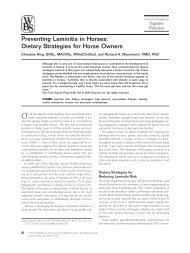Nutritional Secondary Hyperparathyroidism in the Horse
Nutritional Secondary Hyperparathyroidism in the Horse
Nutritional Secondary Hyperparathyroidism in the Horse
Create successful ePaper yourself
Turn your PDF publications into a flip-book with our unique Google optimized e-Paper software.
12 The Anatomy of <strong>the</strong> Parathyroid Glands <strong>in</strong> thc Horsc<br />
b) Present Investigation<br />
Metbods. The upper parathyroids were dissected immediately after<br />
euthanasia (15 horses) or as soon as possible and never later than<br />
5 hours after death (21 horses). After be<strong>in</strong>g weighed, <strong>the</strong>y were split<br />
and fixed <strong>in</strong> Bou<strong>in</strong>’s solution. One-half of each gland was embedded <strong>in</strong><br />
paraff<strong>in</strong>, sectioned at 4 to 6 p, and sta<strong>in</strong>ed with hematoxyl<strong>in</strong> and eos<strong>in</strong>.<br />
The o<strong>the</strong>r half was used for frozen sections at 8 p and sta<strong>in</strong>ed with<br />
scarlet red. Serial section<strong>in</strong>g was not employed.<br />
The parenchyma to <strong>in</strong>terstitium ratio and cytoplasm to nucleus<br />
ratio were determ<strong>in</strong>ed accord<strong>in</strong>g to CHALKLEY (1 943). Briefly,<br />
CHALKLEY’S procedure is as follows : A number of hairs (four, perhaps)<br />
are attached to <strong>the</strong> eyepiece diaphragm, <strong>the</strong> end of each hair represent<strong>in</strong>g<br />
a “po<strong>in</strong>t” <strong>in</strong> <strong>the</strong> microscopic field. If <strong>the</strong> cytoplasm to nucleus ratio<br />
is to be determ<strong>in</strong>ed, <strong>the</strong> “hits” of <strong>the</strong> “po<strong>in</strong>ts” <strong>in</strong> <strong>the</strong> cytoplasm and<br />
<strong>the</strong> nucleus, respectively, are recorded <strong>in</strong> randomly chosen areas. To<br />
avoid a “purely psychologic but very real difficulty,-a very short<br />
extra hair is glued on <strong>the</strong> eyepiece diaphragm; <strong>the</strong>n <strong>the</strong> focus is so<br />
made that <strong>the</strong> tip of this hair is brought <strong>in</strong>to co<strong>in</strong>cidence of <strong>the</strong> focus of<br />
a selected object, usually a nucleus. The position of this po<strong>in</strong>t is not<br />
recorded, but <strong>the</strong> o<strong>the</strong>r po<strong>in</strong>ts alone are used” (CHALKLEY). Twentyfive<br />
hits <strong>in</strong> <strong>the</strong> smaller component of <strong>the</strong> tissue (<strong>the</strong> nucleus when <strong>the</strong><br />
cytoplasm to nucleus ratio is calculated) are recorded. At <strong>the</strong> same<br />
Chart 2. Parenchyma to <strong>in</strong>terstitiurn ratio <strong>in</strong> upper parathyroids of 36 normal<br />
horscs. Ratio on Y-axis, agc <strong>in</strong> years on X-axis, o = male horses, 1 = female<br />
horscs. Solid l<strong>in</strong>e ~ regression l<strong>in</strong>e of ratio as a function of age.<br />
Downloaded from<br />
vet.sagepub.com by guest on April 14, 2010



